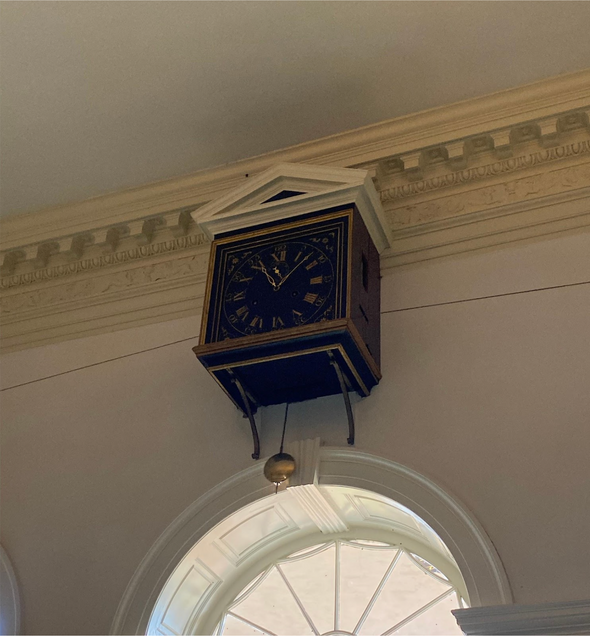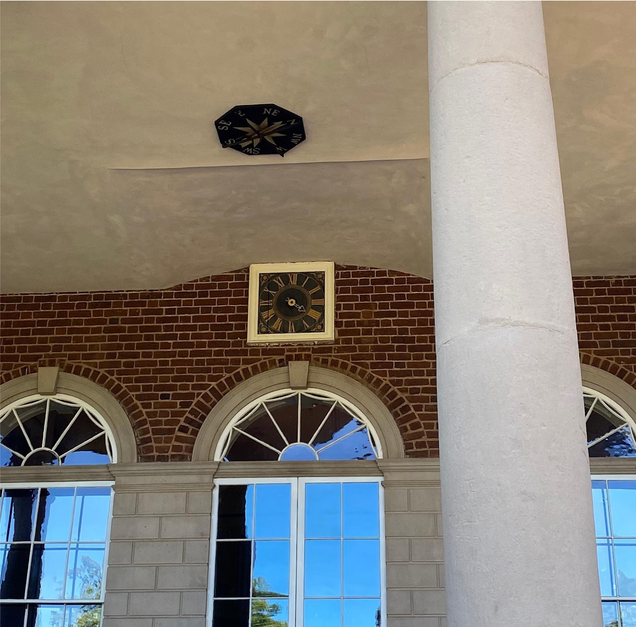Multisensory Experiences in Thomas Jefferson’s Plantations
by Mya Rose Bailey

I first heard the ringing of the Great Clock at Monticello in the dead of summer. The deep, steady resonance of the gong felt as though it could wipe the sweat from my back. I stared as its hammer, now muffled but still deafening in its strike, emanated three low reverberations. And then my three o’clock tour began. I was brought to Monticello by my Master’s thesis, which was concerned with how time and sound were constructed in two of Thomas Jefferson’s plantations in efforts to control Black enslaved labor. By exploring the sensory experience of enslavement through material culture and decorative arts, there is an opportunity to mentally deconstruct objects designed to present unnatural systems—such as race-based enslavement—as intrinsic and necessary to eighteenth- and nineteenth-century life.
Designed by President and enslaver Thomas Jefferson, the Great Clock still stands, as it did for Antebellum audiences, as a marvel of Jefferson’s ingenuity and creativity. Its wooden double-faced body serves as a daily point of reference for internal and external viewers. Once allowed inside Monticello, audiences of the Great Clock can determine the exact time of day through a visible hour, minute, and second hand (fig. 1). Outdoor witnesses, however, only see a single hour hand on the clock’s exterior face (fig. 2). The Chinese gong housed on the roof of Monticello chimes the corresponding hour, reverberating across six miles of the plantation, according to Peter Fossett, one of the nearly six hundred Black people Jefferson enslaved in his lifetime.1

The gong sonically enforced a schedule of labor that could be heard and followed voluntarily by anyone present but was involuntarily heeded by the enslaved community. A constant awareness of the gong’s count signaled when a day’s work began at dawn and ended at dusk, as well as breaks for meals, curfews, and allotted “free” time.2
Monticello in Charlottesville, Virginia and Poplar Forest in Bedford County, Virginia were Jefferson’s most prominent homes and plantations, with a combined ten thousand acres of farmland and nearly two hundred people at a time enslaved across both. To aid in managing this scale of property, Jefferson designed, deployed, and depended heavily on time-keeping and time-telling devices to organize and communicate work schedules to all present laborers.3 Time-telling is best exemplified by objects such as the Great Clock, as its grandeur, permanence, and immovability demand recognition as the standard of regulation in its positioned environment. Multiple case and shelf clocks were also present in more intimate settings for enslaved laborers, specifically the kitchens at both Monticello and Poplar Forest.4 The striking difference between the timekeeping devices’ scale in these spaces suggests the ability of clocks to oversee the bodies, acting as tools of regulation as opposed to entertainment. In contrast to the Great Clock—which would have both delighted and fascinated free visitors to Monticello—these small clocks governed and maintained enslaved bodies and their labor.
One can imagine the rhythmic ticking of a shelf or case clock within the soundscape of a kitchen often occupied by a single cook. The Jefferson family would have set expectations for when a meal should be served, as signalled by the swinging of a hammer chime. Such meals — which would have been made countless times by Monticello cooks — were created both through embodied knowledge and alternative modes of timekeeping (song, prayer, etc.)
This request for a prepared meal at Poplar Forest was commanded by a single brass bell rung by Jefferson that was later excavated from Poplar Forest’s main house.5 The disembodiment of these sounds, and the labor Jefferson demanded through them, is essential in understanding how linear perceptions of time and constructed soundscapes were presented as intrinsic to the hundreds of people he enslaved.
Jefferson’s own understanding of time as both linear and irretrievable was largely informed by European philosophers within the Age of Enlightenment and cultivated his disdain for idleness.6 Jefferson’s subsequent compulsion for efficiency manifested in strict schedules for himself, his family, and the people he enslaved. This temporal imposition was likely disorienting due to the fact that in the Bight of Biafra, where most of his enslaved laborers were taken from in the eighteenth century, time was regarded as unregulated and multidirectional.7 This encourages us—in the contemporary moment—to reconsider the ways enslaved people may have measured, felt, and sounded time within a day. Most importantly, it begs a reconsideration of how we and Jefferson expect time and the sensorium to function for enslaved people. Jefferson himself noted the vibrancy of music and nightlife of those he enslaved in his only full-length book, Notes on the State of Virginia, stating “a black, after hard labour through the day, will be induced by the slightest amusements to sit up till midnight, or later, though knowing he must be out with the first dawn of the morning.”8 The presence of music—specifically music at night, away from the audible demands of labor—suggests another layered soundscape that was not only experienced communally amongst the enslaved but produced by and for themselves as well.
My approach to the sensory experience of enslavement rests upon the acknowledgement that Monticello, Poplar Forest, and the consequent soundscapes of these plantations are all, even loosely, predicated upon slavery in that they only exist because of and to maintain enslavement. Thus, in my interpretation of these constructed temporalities, landscapes, and soundscapes, it is critical to remember there is nothing natural about enslavement. This notion extends to the devices used to both organize and naturalize its practice. Utilizing the senses, especially sound, as both a mode and subject of study permits a more complete picture of the conditions of slavery, both in the ability to place ourselves in the physical landscape of enslaved people and to deconstruct social, cultural, and physical systems that have aided in the dehumanization of enslaved people.
____________________
Mya Rose Bailey (they/she) is an Afro-Caribbean scholar interested in multisensory anthropology, temporality, and memory in Black history and culture. They hold a BA in Art History from SUNY New Paltz and are currently completing their MA in Decorative Arts, Design History, and Material Culture from Bard Graduate Center.
____________________
1. Thomas Jefferson’s Monticello, “Behind the Scenes: Conservation of Jefferson’s Great Clock,” YouTube, 2021. 5:18–5:31, https://youtu.be/c14pjuikHRs?si=JYXg9x-niaLcgaKv.
2. Karen E. McIlvoy, “Traces of Jefferson’s Time at Poplar Forest,” Poplar Forest Archaeology Blog, April 7, 2017, https://www.poplarforest.org/traces-jeffersons-time-poplar-forest/.
3. Art Historian Wu Hung differentiates between time-keeping and time-telling, noting “[t]ime keeping relies on horology and astronomy that allowed governing bodies to regulate seasons, months, days, and hours,” while “[t]ime telling conveys a standardized conventional time to a large, general public.” Wu Hung, “Monumentality of Time: Giant Clocks, the Drum Tower, the Clock Tower,” Monuments and Memory, Made and Unmade, ed. Robert S. Nelson and Margaret Rose Olin (University of Chicago Press, 2003), 108.
4. McIlvoy, “Traces of Jefferson’s Time at Poplar Forest.”
5. “Servant Bells at Poplar Forest,” Poplar Forest Archaeology Blog, February 4, 2016, https://www.poplarforest.org/servant-bells-at-poplar-forest/.
6. McIlvoy, “Traces of Jefferson’s Time at Poplar Forest.”
7. McIlvoy, “Traces of Jefferson’s Time at Poplar Forest.”
8. Thomas Jefferson, Notes on the State of Virginia (University of North Carolina at Chapel Hill Libraries, 2006), 139, https://docsouth.unc.edu/southlit/jefferson/jefferson.html.